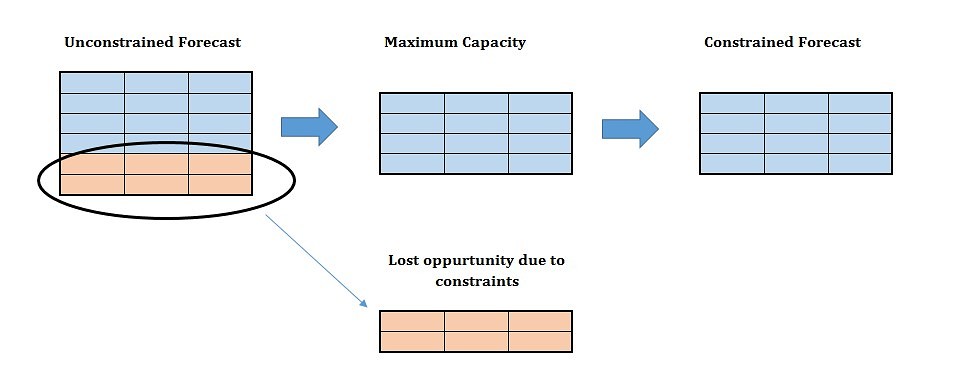When it comes to Sales and Operations Planning, stakeholders at all levels can sometimes find it hard to understand different concepts and the important underlying strategy involved. One of the most important topics I have found in the S&OP process that seems to drive people crazy is The Unconstrained Sales Forecast vs. The Constrained Sales Forecast. The quick explanation is, the start of your S&OP process is an Unconstrained Forecast and the byproduct of your S&OP process is a constrained forecast.
The unconstrained forecast can be confusing to some. The unconstrained forecast is based off the true demand potential that exist when running your forecast with no consideration given to constraints that may exist, such as capacity, materials, cash-flow,etc. The constrained forecast is a forecast constrained by the operations side of the business such as capacity, materials, cash-flow, etc.
A simple example of an unconstrained forecast is: "We only have capacity for 500,000 light bulbs per month. If I have demand signals for 1 million light bulbs per month my unconstrained forecast will show 1 million light bulbs per month."
So, now that we understand what the unconstrained forecast is, why is it important, especially considering the final plan in the S&OP process after being vetted through the supply side will end as a constrained plan that is a reflection of what can actually be achieved. So why waste your time playing pretend and imagining we live in some perfect world where we have no limitations?
Just because your unconstrained forecast gets chopped down to reality, a mature S&OP process will keep the unconstrained forecast as a valuable resource to present to the executive team, in the Executive S&OP meeting. A note on this, be cautious you avoid confusion of people thinking multiple plans are floating around, by the time you are in the Executive S&OP meeting your Constrained forecast is the plan.
Why present the unconstrained forecast to the executive team? Let’s bring everything together now and talk about strategy. Using the lighting company I mentioned earlier, lets assume that the unconstrained forecast reflects 1 million units of light bulbs per month, but you are constrained to 500,000 units a month. The S&OP process has now set the stage for the executive team to easily be alerted to the 500,000 units of potential lost sales per month. Knowing this information should trigger the executive team to implement a strategic plan to increase capacity and handle the constraint hurdles. Below is a visual to help.

So, why is the unconstrained forecast so important? It is the key signal your executive team needs to plan for the future. The executives now have the information to decide if they need to build more manufacturing plants, raise capital, re-negotiate with vendors, hire more employees, etc. On the flip side to this, there may also be the situation where your unconstrained forecast is too low, this will give your executive team the information to make serious decisions in the business such as reduction in force, plant closures, and re-evaluating current sales strategies.


